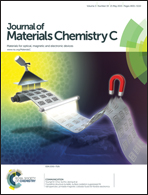Highly improved electro-actuation of dielectric elastomers by molecular grafting of azobenzenes to silicon rubber†
Abstract
Herein we report a novel and efficient approach to fabricate dielectric elastomers with enhanced dielectric constant and high dielectric strength. Azobenzenes with strong permanent dipole moments were synthesized to co-crosslink with hydroxyl-terminated polydimethylsiloxane through a simple one-step process, which realized a type of robust, molecularly homogenous silicone rubber (SR). The chemical structure, dielectric and mechanical properties of the resultant azo-g-PDMS elastomers with azobenzne contents ranging from 0 to 13.2 wt% were carefully characterized. The dielectric constant of azo-g-PDMS films at 1 kHz increased from 2.72 to 4.88 with the increase of azobenzene contents. By grafting with 4.0 wt% of azobenzene, the breakdown strength of azo-g-PDMS reached 89.4 V μm−1, which is 36% higher than that of pristine SR. The electric field induced deformation of silicone rubber could be enhanced by grafting with azobenzenes. The azo-g-PDMS film with 7.1 wt% of azobenzenes displayed a maximum area strain of 17%. Meanwhile, the azo-g-PDMS films exhibited a short response time (about 0.5 s) to the change in the electric field. Some prototype electromechanical actuators based on this type of azo-g-PDMS films were fabricated, demonstrating that the azo-g-PDMS dielectric elastomer is a very promising candidate for artificial muscle applications.


 Please wait while we load your content...
Please wait while we load your content...